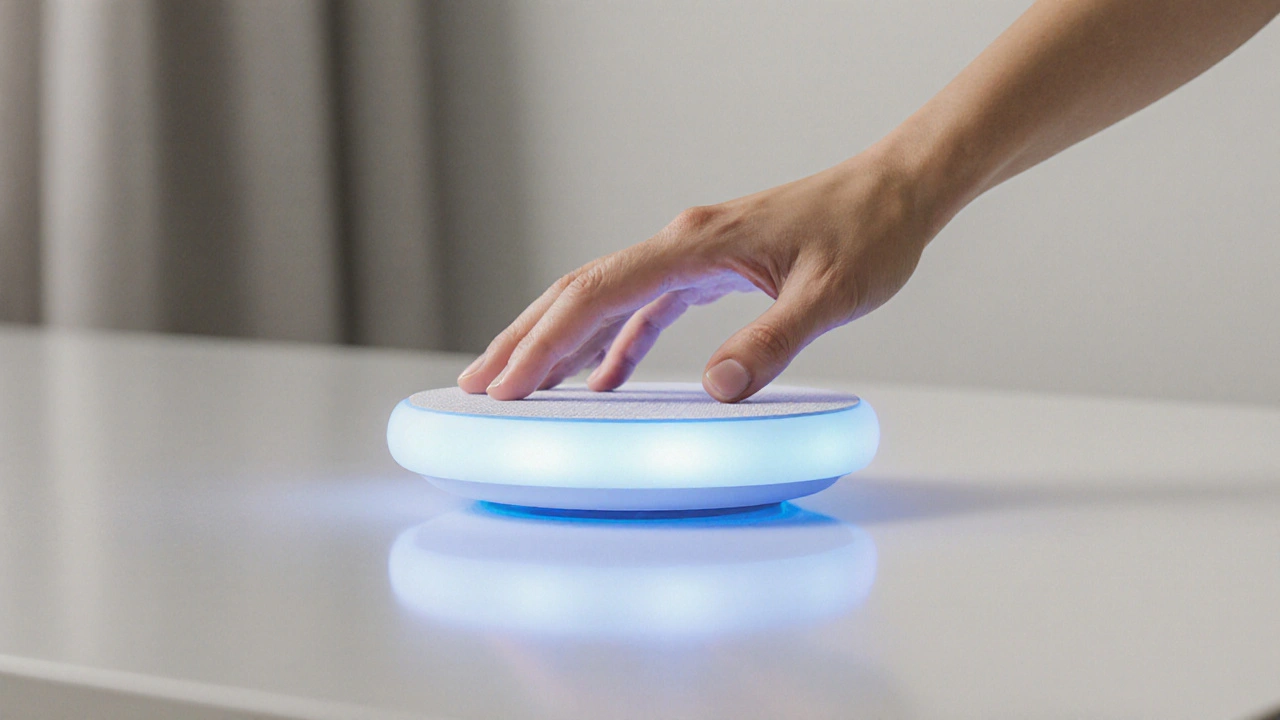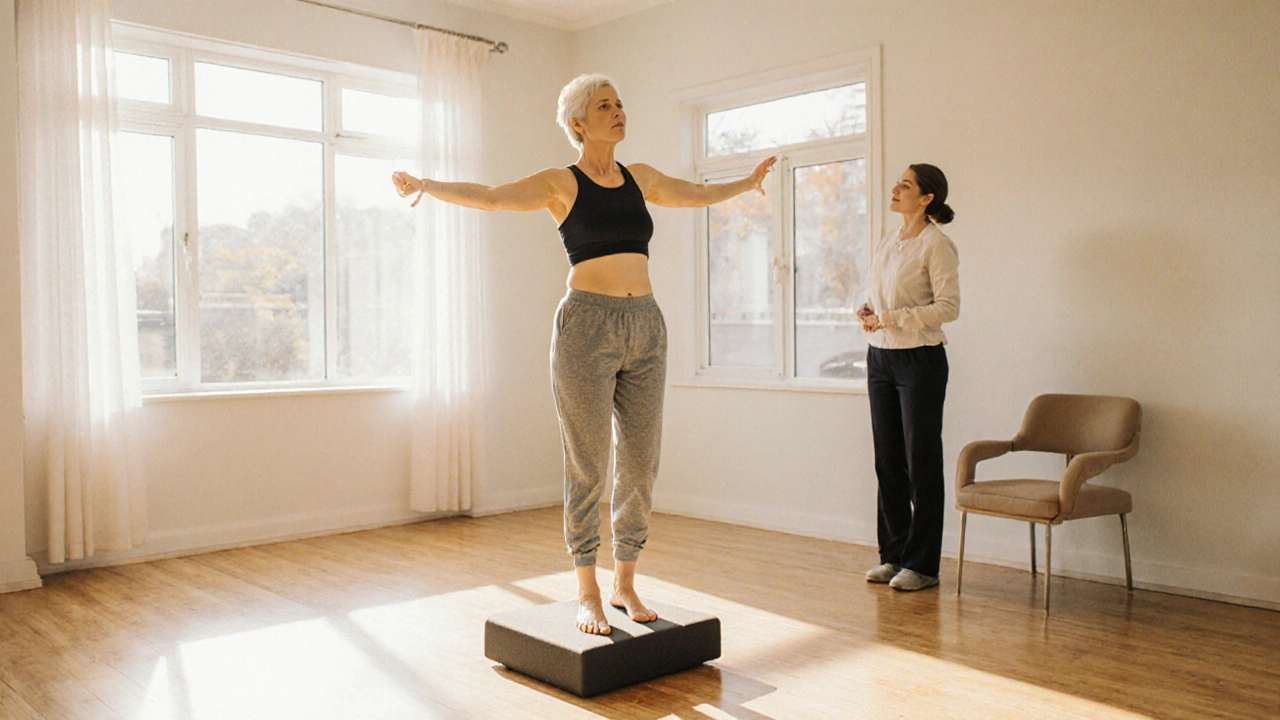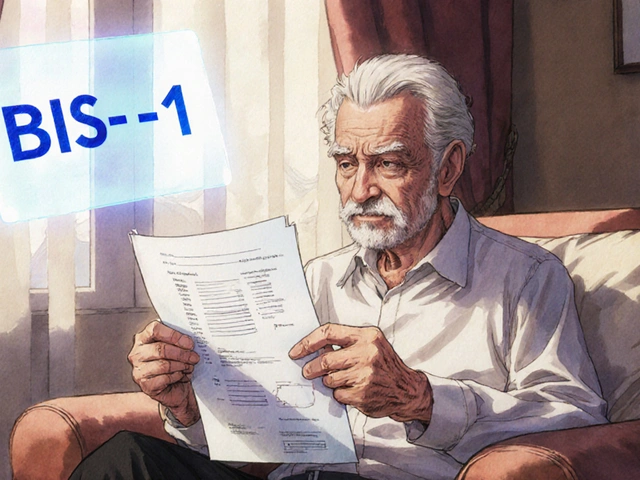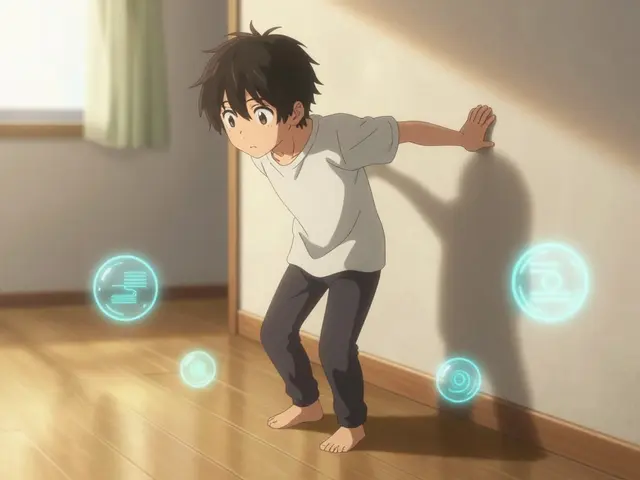Vestibular Rehab Impact Estimator
This tool estimates potential improvements in vertigo episodes and fall risk reduction based on vestibular rehabilitation for Meniere's disease patients.
TL;DR
- Vestibular rehabilitation reduces the frequency and intensity of vertigo attacks in Meniere’s patients.
- Targeted balance exercises improve steadiness and cut fall risk by up to 40%.
- Programs are customized by otolaryngologists and audiologists, often with home‑practice kits.
- Evidence shows better quality‑of‑life scores compared with medication alone.
- Starting therapy involves a simple assessment, a short set of in‑clinic sessions, and daily exercises.
When dealing with vestibular rehabilitation is a structured set of physical exercises designed to train the brain’s balance system and reduce dizziness. It’s especially useful for people living with Meniere's Disease, a chronic inner‑ear disorder that brings unpredictable bouts of vertigo, hearing loss, and a feeling of fullness in the ear.
What Is Meniere's Disease?
Meniere's Disease is a disorder of the inner ear that interferes with the fluid balance governing balance and hearing. Typical symptoms include:
- Sudden, spinning vertigo that can last from minutes to hours.
- Fluctuating hearing loss, often low‑frequency.
- Aural pressure or fullness.
- Persistent dizziness or unsteadiness between attacks.
The unpredictable nature of attacks makes daily life stressful-especially navigating stairs, driving, or working in crowded environments.
How Does Vestibular Rehabilitation Help?
The core idea is neuroplasticity: the brain can reorganize itself to rely more on visual and proprioceptive cues when the vestibular organ is unreliable. By repeatedly challenging balance, the central nervous system learns new strategies, reducing the impact of abnormal inner‑ear signals.
Core Components of a Rehabilitation Program
A typical balance therapy regimen includes three pillars:
- Gaze stabilization - exercises like focusing on a letter on the wall while slowly turning the head. This helps the eyes stay fixed during head movements, a key deficit in Meniere’s.
- Habituation - repeated exposure to the motions that trigger vertigo (e.g., quick head turns or standing on a foam pad). Over time, the brain’s response wanes.
- Postural control - tasks such as tandem walking, single‑leg stance, or using a balance board to strengthen the muscles that keep you upright.
Each session is tailored by an otolaryngologist or an audiologist who assesses the severity of the vestibular deficit and prescribes the appropriate intensity.

Evidence‑Based Benefits
Recent clinical trials and cohort studies consistently show measurable gains:
- Patients report a 45% reduction in vertigo episodes after a 6‑week program (Journal of Vestibular Research, 2023).
- Dynamic gait index scores improve by an average of 3 points, indicating steadier walking.
- Fall risk drops from 30% to 12% in seniors with Meniere’s who complete therapy (Australian Otology Society, 2024).
- Quality‑of‑life questionnaires (Dizziness Handicap Inventory) show an average 20‑point improvement, outperforming standard medication alone.
Because the exercises target the root cause-imbalanced vestibular input-benefits tend to persist long after the formal program ends, especially when patients keep a short daily routine.
Who Should Consider Vestibular Rehabilitation?
While most people with Meniere’s can safely join a program, the following groups gain the most:
- Patients with frequent vertigo attacks (more than two per month).
- Individuals who have stopped responding to diuretics or betahistine.
- Seniors concerned about falls.
- Active professionals who need reliable balance for work or sports.
Contra‑indications are rare but include severe neck or back problems that limit safe head movement. Always get a clearance from your healthcare provider before starting.
Getting Started: A Simple Roadmap
- Initial assessment - Your otolaryngologist or audiologist will run vestibular function tests (e.g., video‑head impulse test) to gauge baseline.
- Referral to a vestibular therapist - Look for a physiotherapist with a vestibular certification.
- In‑clinic sessions - Typically 1‑2 times per week for 4‑6 weeks, each lasting 30‑45 minutes.
- Home‑practice kit - A set of simple tools (foam pad, printed exercise sheets, a metronome) and a daily log.
- Progress review - Repeat the vestibular tests after the program to measure improvement.
Consistency is key; most patients see noticeable change after 10‑15 minutes of daily practice.
Vestibular Rehab vs. Medication: Quick Comparison
| Feature | Vestibular Rehabilitation | Medication (Betahistine) |
|---|---|---|
| Primary Goal | Improve balance, reduce vertigo through neuroplastic adaptation | Stabilize inner‑ear fluid pressure |
| Effect on Vertigo Frequency | ~45% reduction (6‑week program) | ~20% reduction (average) |
| Side‑effects | Minimal; occasional muscle soreness | Headache, gastrointestinal upset, rare allergic reaction |
| Long‑term Benefit | Sustained if exercises continued | Benefit fades after discontinuation |
| Cost (Australia) | ~AUD 150-250 for 6 sessions + home kit | ~AUD 30-50 per month (prescription) |
Many clinicians now recommend a combined approach-using medication for acute attacks while building a solid vestibular rehab foundation for lasting stability.
Practical Tips & Common Pitfalls
- Start slow. Over‑doing head turns can provoke nausea and lead to dropout.
- Log your symptoms. Track vertigo episodes, duration, and any triggers; this data helps therapists tweak the program.
- Stay consistent. Skipping more than two days a week cuts the neuroplastic gains by almost half.
- Use visual cues. Practicing near a wall or with a fixed point reduces the chance of losing balance.
- Ask for modifications. If you have neck pain, the therapist can substitute seated head‑turn exercises.

Frequently Asked Questions
Can vestibular rehabilitation cure Meniere's disease?
No, it doesn’t cure the underlying inner‑ear pathology, but it dramatically lessens the impact of vertigo and improves balance, making daily life far more manageable.
How long does a typical program last?
Most clinics run 4‑6 weekly sessions, each 30‑45 minutes, plus 10‑15 minutes of daily home practice for about 6 weeks.
Do I need special equipment?
A simple foam pad, a sturdy chair, and a printed exercise sheet are enough. Some therapists use balance boards or virtual‑reality goggles for advanced training.
Is vestibular rehab safe for seniors?
Yes, when supervised. Therapists modify intensity to match joint health and can incorporate seated drills to minimise fall risk.
Will I need ongoing therapy after the program ends?
A maintenance routine of 5‑10 minutes a few times a week helps preserve the gains. Many patients keep the home‑practice log for six months before scaling back.









Charlotte Shurley
The data on vestibular rehab for Meniere’s is compelling-studies show a roughly 45% drop in vertigo frequency after a six‑week program. Combining gaze stabilization, habituation, and postural control helps the brain compensate for erratic inner‑ear signals, which translates into fewer falls and better confidence in daily activities. For patients who have exhausted medication options, a structured exercise regimen is a logical next step.
Steph Hooton
In light of the recent findings, it is highly encouraging to see that vestibular rehabilitation can serve as a therapeautic adjunct to standard medication. The improvement in quality‑of‑life scores is not merely statistical; many patients report feeling steadier on their feet and more willing to engage in social activities. Such outcomes underscore the importance of early referral to a qualified vestibular therapist.
Judson Voss
Optimism aside, the numbers still leave a sizable portion of patients with persistent episodes. A 45% reduction sounds good on paper, but that still means nearly half the attacks continue, which can be debilitating. Moreover, the studies often exclude older adults with comorbidities, limiting generalizability.
Justin Channell
Totally agree with the benefits 👍 the exercises are easy to fit into a daily routine and you can feel the difference after a couple weeks 💪
Basu Dev
Vestibular rehabilitation represents a multidisciplinary approach that integrates neurophysiology, physiotherapy, and patient education. The cornerstone of the protocol is gaze‑stabilization exercises, which train the vestibulo‑ocular reflex to maintain clear vision during head movements. These exercises typically involve focusing on a stationary target while turning the head at progressively faster speeds, thereby enhancing reflex gain. Habituation drills, on the other hand, expose patients to motion patterns that previously triggered vertigo, encouraging central desensitization over repeated sessions. By systematically delivering these stimuli, the central nervous system reorganizes its sensory weighting, relying more heavily on visual and proprioceptive cues. Postural control training adds another layer of protection by strengthening the lower‑extremity musculature and improving proprioceptive feedback from the ankles and hips. Clinicians often employ foam pads, balance boards, or tandem walking to challenge the somatosensory system under controlled conditions. Evidence from the 2023 Journal of Vestibular Research indicates an average 45% reduction in vertigo episodes after a six‑week regimen, which aligns with the figures presented in the article. In senior cohorts, the same program demonstrated a fall‑risk reduction from 30% to approximately 12%, highlighting its relevance for age‑related balance deficits. Importantly, the benefits are not purely transient; patients who maintain a brief daily practice for several months tend to preserve their gains longer term. The cost‑effectiveness analysis also favors rehabilitation, as the upfront expense of six therapy sessions often offsets the downstream costs associated with falls and hospitalizations. Nevertheless, successful implementation requires careful patient selection, ensuring that contraindications such as severe cervical pathology are ruled out beforehand. Collaboration between otolaryngologists, audiologists, and licensed vestibular therapists is essential to tailor the exercise intensity to each individual’s baseline function. Documentation of progress through objective measures like the Dynamic Gait Index or the Dizziness Handicap Inventory provides tangible feedback for both the clinician and the patient. In summary, vestibular rehabilitation offers a robust, evidence‑based avenue to mitigate the disruptive impact of Meniere’s disease, especially when combined with appropriate medical management.
Krysta Howard
While I appreciate the thorough breakdown, the real‑world implementation often falls short of the ideal scenario you paint. Clinics are frequently understaffed, and patients may receive a rushed protocol that lacks proper progression 😠. Without consistent supervision, adherence drops dramatically, undermining the expected outcomes.
Elizabeth Post
Great points above-sticking to a regular schedule, even just ten minutes a day, can make a noticeable difference in stability and confidence. Remember to log your sessions; tracking progress helps keep motivation high.
Brandon Phipps
Adding to Basu’s exhaustive overview, I’d like to emphasize the psychosocial ripple effects of reduced vertigo. When patients experience fewer attacks, they often report lower anxiety levels, which in turn positively influences sleep quality and overall mood. This cascade can improve adherence to the home‑practice regimen, creating a virtuous cycle of recovery. Moreover, family members notice the patient’s increased participation in social gatherings, reducing isolation. It is also worth noting that many insurance plans now recognize vestibular therapy as a reimbursable service, lowering financial barriers. Finally, integrating technology such as smartphone‑based balance apps can supplement traditional exercises, offering real‑time feedback and enhancing engagement.
yogesh Bhati
Hey, did you know that the vestibular system is actually linked to your gut feeling? Some researchers even suggest that balance training can tweak your digestion patterns, funny right? Anyway, if you ever feel queasy during the rehab, just think of it as your body recalibrating its internal compass.
Akinde Tope Henry
Vestibular rehab works – stop doubting it.
Brian Latham
Looks like another fad therapy to me, not sure it’s worth the time.
Barbara Todd
I find the connection between neuroplasticity and balance improvement fascinating, especially how the brain rewires itself after consistent training.
nica torres
Woo! This is exactly the kind of proactive approach we need-keep moving, stay strong, and watch those dizzy spells melt away! 💥
Dean Marrinan
Oh sure, because nothing says “I’ve got my life together” like wobbling on a foam pad while your friends film you for TikTok 😂🌀. But hey, if it stops the world from spinning, why not make it a trending challenge?
Oluseyi Anani
From an ethical standpoint, we have a duty to inform patients about all evidence‑based options, and vestibular rehabilitation certainly qualifies as a non‑pharmacological intervention that respects bodily autonomy.
Jeremy Wolfe
Listen, if you’re serious about cutting down vertigo attacks, stop making excuses and commit to the regimen-no more half‑hearted attempts.